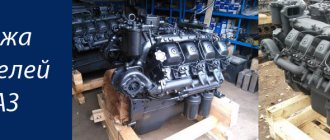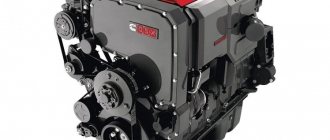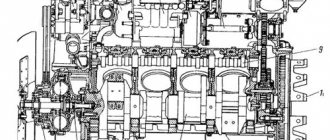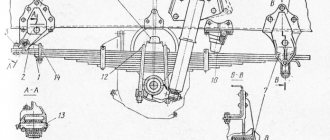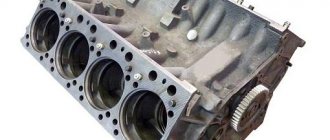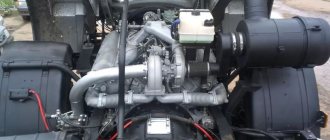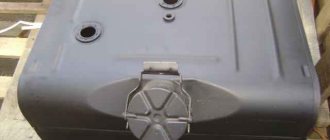A hydraulic coupling (abbreviated as hydraulic coupling) is installed on the engine of KamAZ vehicles to drive a fan to cool the liquid passing through the radiator. The fan is turned on and off using a fluid coupling depending on the temperature in the engine cooling system. If problems arise during operation, you will need to diagnose the cause and eliminate the malfunction by repairing the fluid coupling or replacing this part. If the exact cause of failure cannot be determined by external signs, then it is necessary to resort to dismantling and disassembly. What elements it consists of, how it works and how to diagnose and repair a hydraulic coupling failure - read in this article.
Diagram of the hydraulic coupling of the KamAZ 740 engine fan drive
- thermal power sensor mounting nut
- thermal power sensor assembly
- adjusting washer
- switch housing assembly
- fluid coupling switch spool
- return spring washer
- return spring
- switch housing o-ring
- switch housing cover
- faucet plug cover
- faucet plug lever retainer
- retainer spring
- valve plug lever
- spring washer
- cover bolt
- lever mounting pin
- faucet plug o-ring
- switch tap plug
- front cylinder block cover assembly
- hydraulic coupling drive wheel (740-1318032) Has 33 blades. The wheel is connected to the crankshaft through the splined part of the power take-off shaft. Such a wheel mechanism is inextricably linked with a driven shaft, which drives the cooling fan of the power unit system. Therefore, you can most often purchase a wheel complete with a shaft. Catalog number - 740.1318044
- screw
- lock washer
- hydraulic coupling driven wheel (740.1318046) Has 32 blades
- bolt securing the drive wheel to the casing
- hydraulic coupling drive shaft with casing assembly
- fluid coupling bearing housing
- bearing housing tube
- indicator for setting the fuel injection advance angle
- spring washer
- bearing housing mounting screw
- bearing ring
- bearing ring
- drive shaft ball bearing
- drive shaft o-ring
- drive shaft limiting washer
- limit washer retaining ring
- ball bearing rear driven shaft
- flat washer for the driven wheel mounting bolt
- lock washer
- driven shaft mounting bolt
- hydraulic coupling driven wheel shaft
- generator drive shaft ball bearing
- generator drive pulley shaft
- spring thrust ring
- generator drive pulley shaft cuff
- ball bearing front driven shaft
- generator pulley gasket
- generator drive pulley
- driven shaft cuff with spring
- spring washer
- pulley bolt
- cuff sleeve
- fan impeller hub
- lock washer
- low hub fastening nut
Fluid coupling switch
- switch housing cover
- switch housing
- return spring washer
- return spring
- fluid coupling switch spool
- O-ring of the switch housing cover
- faucet plug o-ring
- switch tap plug
- pin
- valve plug lever
- retainer spring
- faucet plug lever retainer
- faucet plug cover
- shims
- thermal power sensor mounting nut
- thermal power sensor
- thermosil seal ring
Fan drive operating modes
There are three operating modes of the fluid coupling. Changing the mode is achieved by changing the position of the switch flag. The positions are indicated in the image below, and the operating modes are also described.
- Auto mode. The coolant temperature in the engine is maintained at 80-95 degrees. The hydraulic coupling switch valve is set to position B (mark on the switch body)
- The fan is turned off. The hydraulic coupling switch valve is set to position O. In this case, the fan can rotate at a low speed.
- The fan is constantly on. (locked) Operation in this mode is allowed only in emergency cases in case of malfunctions for operation in automatic mode. Operating the fan for a long time without turning it off can lead to wear and tear of the impeller. To enable this mode (if necessary), you will need to loosen the locknuts of two special bolts securing the impeller to the hub and screw the bolts so that they fit into the hole on the fan drive pulley. Retighten the nuts. When returning to automatic mode, unscrew the bolts and lock them in such a position to ensure free rotation of the fan relative to the pulley and reliable fastening of the impeller to the hub.
The principle of operation of the KamAZ fluid coupling
- The running engine drives a pump-type wheel.
- The working fluid, which is located in the space between the blades, begins to spin and is then thrown away from the rotational axis to the periphery of the wheel mechanism.
- The liquid gains kinetic energy and speed. It moves in the same direction as the pump wheel.
- After this, the working fluid is shifted from the pump wheel to the turbine wheel mechanism.
- In the space between the blades, fluid particles begin to influence the turbines, causing them to rotate at angular speed. During this rotation, the fluid particles transfer their kinetic energy to the turbine wheel.
- The liquid moves to the periphery of the turbine mechanism, after which it returns to the pump wheel.
- The whole process is repeated again, circulating in the space between the blades.
- The fluid coupling activates the fan, which begins to blow on the radiator, cooling the working fluid.
- When the oil temperature drops, the clutch switch is activated and the fan stops running.
Flushing the cooling system
There are different ways to flush the cooling system. In case of minor contamination, you can rinse with plain water. To do this, the old coolant is drained and water is added instead. The engine starts and warms up at idle speed. After this, the water is drained and the entire cycle is repeated several times until completely cleaned.
If the contamination in the system is significant, it is best to use special ready-made flushes. At the same time, there are quick options when flushing is simply added to the old antifreeze, and then everything is drained. But it is better to use flushing solutions when the old coolant has already been drained. It should also be taken into account that to clean the engine water jacket, the cleaning solutions will be different. The cooling system radiator should be flushed separately for more effective cleaning. A 2.5% hydrochloric acid solution has worked well for this.
One of the features of flushing should be known that the direction of the flushing flow should be opposite to the normal flow of the coolant. It will be more effective to flush the system with a stream of water or a chemical solution under pressure.
The most common malfunctions, their causes and solutions
- Increased temperature of antifreeze or antifreeze in the cooling system of the power unit. This may be caused by: - insufficient amount of working fluid in the system. (Make sure there is no leakage and add coolant to the required level.) - insufficient tension of the water-type pump drive belts or their breakage. (Replace or ensure proper tension of drive belts) - thermostat malfunction. (Replace the thermostat) - contamination of the surface of the radiator part. (Clean the radiator from dirt, make sure there is normal circulation of coolant in the radiator.) - slow rotation or stop the fan. (In this case, it is necessary to replace all worn elements, rinse the system with clean water, adjust the belt tension, add antifreeze and fix the blinds.)
- Reduced fluid temperature. This may be caused by:
Features and Important Elements
The KAMAZ vehicle, whose cooling system is practically no different from the classic one, works optimally. In case of deviations, the car’s engine faces considerable trouble. The composition of the main elements of the system is almost the same as that of a passenger car:
- cooling radiator;
- water pump;
- pipes;
- thermostats;
- cooling Fan.
One difference from the cooling system of non-truck vehicles is immediately visible - the presence of 2 thermostats. This is due primarily to the structural features of the engine. The V-shaped eight has two cylinder heads located at an angle of less than 90 0 (hence the name). The next distinctive feature is the shutters on the cooling radiator. During the cold season, they are in the closed position and allow the engine to quickly warm up.
The cooling system (KAMAZ 740) includes a hydraulic fan clutch. The controlled drive allows you to automatically adjust the fan speed, thereby intensively cooling the engine.
Removing and replacing the hydraulic coupling
- Tilt the driver's cab to the second fixed position.
- Loosen the generator mounting nut.
- Remove the fluid pump drive belt.
- Remove the engine oil sump and oil cooler.
- Unscrew the mounting bolts and remove the filter responsible for centrifugal oil purification.
- Unscrew the front bracket screws and loosen the shoe nuts.
- Raise the front of the engine and place blocks of wood under the engine.
- Unscrew the bolts and washers where the front cover is attached to the cylinder block.
- Remove the fluid coupling along with the cover and casing.
- Install the new mechanism and reassemble, performing all steps in reverse order.
Adjusting the switch (switch) of the KamAZ fluid coupling
The fluid coupling switch is the weakest point of this unit. The stability of the fan operation depends on it.
The problem is detected by the engine temperature: for example, if the temperature does not drop below 105 ° C, then most likely the switch does not operate correctly. The same reason may occur when the temperature drops below normal.
The operation of the switch is determined by the indicators of the thermal power sensor, which is in direct contact with the antifreeze, measuring the temperature and, if necessary, turns the system on/off. It is this element that is responsible for supplying oil.
Troubleshooting the switch operation involves adjusting the number of rings between the thermal power sensor and the regulator. Any experienced driver can handle such work; the fault can be easily fixed with your own hands. Most often, it is necessary to change the threshold temperature when there is insufficient cooling. In order for the fan power to increase and cooling to be intense, the number of rings must be reduced. Sometimes the problem is that the temperature has dropped too much, then rings need to be added. There are many videos in the public domain that show in detail the process of adjusting the KamAZ fluid coupling switch.
Crimping
The cooling system (KAMAZ 65115) must be completely sealed. A visual check is good, but may not show areas that are about to start leaking. To identify such weak points, it is good to use a pressure gauge and a pump to create pressure.
To perform pressure testing, it is enough to apply pressure to the upper radiator inlet with a pump, start the engine and watch the pressure gauge reading. If everything is fine and there are no gaps in the system, the arrow of the device will not change its position. Otherwise, when the arrow starts to go down, all that remains is to find the problem area.
KamAZ hydraulic coupling repair
Disassembling the hydraulic fan coupling is performed in the following sequence:
- Install the hydraulic coupling on a special device. To do this, you can use a beam crane, suspension, etc.
- Unbend the locking mechanism.
- Remove the fan hub mounting.
- Press the hub off the hydraulic coupling.
- Unscrew the pulley mounting bolts and remove it.
- Remove the cuff and gasket.
- Remove the cuff bushing.
- Remove the ring from the spring mechanism.
- Remove the advance angle of the fuel injection system.
- Remove and press the driven wheel.
- Unscrew the studs from the threaded connections.
- Wash all contaminated parts with antifreeze or gasoline.
Replacing the front seal (oil seal) of the KamAZ hydraulic coupling
- Unscrew all the mounting bolts from the pump wheel and remove it.
- Disassemble the pump.
- Pull out the worn out oil seal.
- Remove the pan and clean all filter elements with clean water.
- Open the housing of the pump mechanism and clean the mesh with oil or gasoline.
- Reassemble in reverse order.
Disassembly of the hydraulic coupling. Detailed Guide
The digital designations correspond to those indicated on the schematic image of the fluid coupling above in this article.
Using a puller, press the hub from the hydraulic coupling shaft 41. Having unscrewed and removed the bolts 51 with washers 50 securing the generator drive pulley 48, remove the pulley assembly with cuff 49, gasket 47 and sleeve 52 of the cuff from the fluid coupling shaft.
Having removed the inner spring ring 31 of the bearing mounting, unscrewing and removing the screws 30 with washers 29 securing the bearing housing, remove the indicator 28 for setting the fuel injection advance angle and the bearing housing 26 assembled with the drive shaft bearing 33. The hydraulic coupling of the fan drive assembly is removed from the front cover of the cylinder block.
Having straightened the lock washers, unscrew the bolts securing the drive shaft 25 with the casing assembly to the drive wheel 20 and remove the bolts with nuts and washers and the drive shaft with the casing assembly. The driven wheel 23, assembled with the driven shaft 41, is removed from the drive pulley shaft. After unscrewing and removing the bolts 40 with washers 39 and 38 securing the driven wheel to the driven shaft, the wheel is pressed from the shaft using a mandrel. Bearing 37 is pressed from the rear end of the shaft using a puller. After unscrewing and removing the bolts and washers securing the drive wheel 20 to the generator drive pulley shaft 43, heat the drive wheel assembly with the shaft and bearing 42 in an oil bath to a temperature of 100°C and remove it from the shaft drive wheel and oil deflector. Using a puller, bearings 42 and 46 are pressed from shaft 43. The thrust ring 44 is removed from the internal groove of the shaft.
From the drive shaft of the fluid coupling, remove the outer spring ring 32 of the bearing 33 and the sealing rings 34 (on the latest cars, the sealing rings are canceled). Using a puller, drive shaft bearing 33 is pressed out of the bearing housing 26 seat. The cuff 49 is pressed out from the socket of the generator drive pulley 48. When the studs are loosened in the threaded connections of the front cover of the cylinder block, the studs are unscrewed.
On cars of early years of production, remove the locking ring 36 and the limit washer 35, press the cuff 45 out of the socket of the front cover of the cylinder block.
Defects of fluid coupling parts
Before troubleshooting, parts must be cleaned of contamination.
The driven shaft of the fluid coupling is rejected if there are breaks or cracks, the journal for the front bearing is worn to a diameter of less than 24.98 mm, and the journal for the rear bearing is worn to a diameter of less than 19.99 mm. Spline wear is determined by measuring the lateral clearance in conjunction with a new part. If the lateral clearance is more than 0.25 mm, the shaft is rejected.
The drive shaft of the fluid coupling is rejected if there are breaks or cracks, wear of the bearing hole to a diameter of more than 47.05 mm and wear of the bearing journal to a diameter of less than 19.99 mm. Spline wear is determined by measuring the lateral clearance in conjunction with a new part. If the lateral clearance is more than 0.25 mm, the shaft is rejected.
Loosening of the casing is determined by light blows of a copper hammer. If this defect is present, the rivets should be upset or replaced.
The drive wheel of the fluid coupling is rejected if there are breaks or cracks, as well as if the hole for the generator drive pulley shaft is worn to a diameter of more than 70.06 mm.
The fluid coupling bearing housing is rejected if there are breaks or cracks, as well as if the bearing seat is worn to a diameter of more than 72.02 mm (part 740.1318075) or 110.05 mm (part 740.1318075-10).
After cleaning all the elements, it is necessary to replace the worn parts with new ones. When the cause of the malfunction is unknown, you need to disconnect the fluid coupling from the fan, carefully disassemble the internal structure of the mechanism, blow out all the working fluid supply channels and check the torsional stability of all wheels. If any malfunctions are identified, eliminate them and assemble and install the fluid coupling on the engine.
kind people, help in any way you can. Kamaz 5320 engine 740. everything was great, just a little tweaking. I chose the time to give the equipment for repair. A day later I pick it up, put everything on the mark, the engine started with half a turn. Warmed it up, drove 5 km. temperature 90, another 5 km - 100. I called the fuel man - he said to look for the problem in the fluid coupling. I raised the cabin on a forced lever - I can easily hold the fan with my hand - I can even spin in the opposite direction. Please tell me where to start?
The ignition is set to four. Everyone unanimously shouts that this is the norm. Tried earlier, later - no changes, it still gets hot. I called the fuel man and said that it can warm up with a late ignition.
This can be individual for each engine... for me it’s on the 3rd risk... but as for the late one, your fuel engineer is confused...
This can be individual for each engine... for me it’s on the 3rd risk... but as for the late one, your fuel engineer is confused...
“Kind people, help in any way you can. Kamaz 5320 engine 740. everything was great, just a little tweaking. I chose the time to give the equipment for repair. A day later I pick it up, put everything on the mark, the engine started with half a turn. Warmed it up, drove 5 km. temperature 90, another 5 km - 100. I called the fuel man - he said to look for the problem in the fluid coupling. I raised the cabin on a forced lever - I can easily hold the fan with my hand - I can even spin in the opposite direction. Please tell me where I can start?”
It happened with a fluid coupling. We removed the switch and used a wire to clean the small holes in the block (oil supply to the fluid coupling). They were full, this happened on two cars.
The ignition is set to four. Everyone unanimously shouts that this is the norm. Tried earlier, later - no changes, it still gets hot. I called the fuel man and said that it can warm up with a late ignition.
It heats up early, then it stops doing so, and it’s imperative that the clutch, radiator and pump are in order)))
all the guys, the season has begun))) I prepared the car for 2 months, I was sure that everything was in order, the 1st trip - 2 slopes, oil was flowing through the just changed main oil seal, it’s just that women are less capricious than our Tatars)))
A guy I know in the parking lot is struggling with a Kamaz and getting warm. it stood for more than 5 years, he took it in the winter, and now... he cleaned the radiator, replaced the impeller on the pump, the thermostats, the flag on a permanent basis... in short, the block needs to be cleaned... has anyone encountered this? How is it, to make it easier? Remove the heads or sleeves too? I filled in some kind of flushing, to no avail..
I, too, as soon as the sealants appeared, I don’t remember what I installed, in general I anointed them generously, installed them, and filled all the holes with them.
a friend bought a pump, NSh-50, left, and doesn’t know where the entrance is and where the exit is. please tell me how to determine. There are no inscriptions or arrows...
All these reasons are easy to notice and it is not difficult to eliminate them, but with problems in the operation of the car itself, as a result of which overheating can occur, the matter is a little more complicated.
Overheating of the KAMAZ engine is a very common problem and the reason for replacing or repairing the engine with a new one. Unfortunately, not every hired driver admits that during the season he boiled over 10 times, and at the last moment the engine just stopped. More than once there have been situations where people, having bought a new KAMAZ engine, report a motor malfunction during the warranty period, citing a low-quality unit. But during the inspection it turns out that the engine was boiling, and this is not a warranty case. Treat your equipment with care, especially do not overload a car with a new engine in the first days, this will greatly affect the service life of your engine.
Regardless of the manufacturer, we open KAMAZ engines handed over to us under warranty with suspicion of overheating in the presence of the client or make a detailed high-quality video. If a boiling line is noticed on the cylinder liner, we will, in most cases, deny the warranty.
In the general literary section about the KAMAZ engine. If you want to buy or find out the cost, use the main menu.
We also recommend reading:
The main factors mean that the motor should be checked. Engine repair process and possible costs. How to solve the situation by saving time and money. Read the material.
Copying information from the site is prohibited and is monitored.
Please note that this website is for informational purposes only and under no circumstances constitutes a public offer as defined by the provisions of Article 437 of the Civil Code of the Russian Federation. Any prices and information may be out of date.
Engine overheating is one of the most common causes of engine breakdowns. The normal operating temperature for the engine is 82° - 95°C. If the Kamaz engine heats up more than 100°C, this may indicate a malfunction of the engine.
Common causes of overheating:
- Operating conditions: slow speed, high loads, high ambient temperature.
- Faulty thermostat;
- Faulty coolant temperature sensor;
- Fan malfunction, be it an electric fan or a fluid-coupled fan;
- Clogged radiator;
- Broken water pump drive belt
- Water pump malfunction;
- Low coolant level;
- Poor quality fuel;
- Poor quality oil, clogged oil filter.
How does the engine overheat?
Slight overheating
The engine ran for 5-10 minutes at elevated temperatures. This happens when the driver notices overheating in time and turns off the engine, for example, when a fan or thermostat fails. The consequences are minor - the pistons may melt. For modern engines, such overheating is not at all critical.
Average degree of superheat
Appears when the engine is running at extreme temperatures for at least 20 minutes. . This leads to a distortion of the plane of the cylinder head or the formation of a crack in the cylinder head, which in turn can lead to the valve seat flying out of place. The cylinder head gasket may burn out, severe deformation of the pistons, destruction of the partitions between the rings on the pistons, and the seals will warp.
Severe overheating
Causes very serious consequences, the engine may knock and jam. The pistons begin to melt and burn out until they are completely destroyed; the molten aluminum sticks to the cylinder walls, making the piston stroke more difficult. Engine oil loses its lubricating properties at elevated temperatures, lubrication of rubbing parts stops, main and connecting rod bearings melt and stick to the crankshaft and can turn. The cylinder head begins to deform, valves burn out, valve seats fly out, and a sharp, loud knock appears in the upper part of the engine.
What to do if you overheat
If there is slight overheating, you need to let the engine idle for a couple of minutes, and only then turn it off. In case of severe overheating, turn off immediately to prevent more serious problems.
The boiling line on the cylinder liner of the KamAZ engine is the reason for the refusal of warranty.
What causes overheating
- The coolant is running low or there is not enough coolant in the system. There may be an internal leak of antifreeze, which will flow directly into the engine crankcase, this will help dilute the engine oil used. Water hammer may occur or the crankshaft may seize unexpectedly.
Faulty thermostat.
Deposits that collect inside the system responsible for cooling contribute to jamming of the moving element of the thermostat itself.
Ineffective radiator operation.
The main reason is dirt that collects in the space between the radiator fins.
Incorrect adjustment of the ignition or injection systems. If the adjustments are violated, this significantly affects the burning of the working fluid, in which case engine damage may occur. The exhaust gases significantly increase their temperature and the cylinder head begins to overheat greatly, which leads to the boiling of antifreeze.
The exhaust valve begins to burn out. This malfunction will also have quite serious consequences for your vehicle - engine parts will significantly overheat due to the fact that the temperature of the exhaust gases will increase.
Buy spare parts from us:
Buy spare parts from us:
Checking the electromagnetic clutch of the car fan BJ1044
When the radiator fan stops spinning, you don’t need to immediately run to the store to buy a new one, you need to determine the cause of the malfunction; perhaps it can be easily eliminated, or perhaps it is not the fan itself that is to blame. How to check the electromagnetic clutch of a BJ1044 car, read the instructions.
To check the functionality of the coupling, you need to connect the wire to the positive and short it to the wire that comes out of the pump, that is, when the circuit is closed and opened, the electromagnet should click, this will mean that the pump is in working condition.
The same applies to checking the old pump, in this case you need to short the housing to negative and the wire to positive; if nothing clicks, it means that the electric coupling is not working.
The following is a diagram of the activation and control of the electric coupling.
Gray with a black stripe – standard wiring (minus), yellow – power supply to the electric coupling relay
Parameters of the electromagnetic clutch of the ZMZ-405 pump:
- Supply voltage – 10.8 – 15 V.
- Electrical power consumption – no more than 50 W.
- The transmitted torque at a voltage of 12V is at least 20 Nm (2 kg/cm).
- The minimum response voltage is 10 V.
- The minimum voltage for transmitted torque is not less than 11 Nm (1.1 kgf/m).
- The gap between the pulley and the driven disk is 0.2 - 0.5 mm.
Procedure for checking the electromagnetic fan clutch:
- Before checking the functionality of the electromagnetic fan clutch, check the functionality of the activation sensor by dismantling it and checking it for the activation temperature (78±20 °C).
- Check the connections of the wires of all coupling elements.
- Warm up the engine to operating temperatures and use a tachometer mounted on the fan pulley and fan to determine when the fan turns on. In the absence of a tachometer, the moment of switching on can be determined using the hearing: the fan noise increases sharply at the moment the clutch is switched on, and it is necessary to control the engine temperature and prevent the engine from overheating.
- To check the functionality of the coupling itself, you must do the following:
- disconnect the green wire going from the clutch coil to the clutch engagement sensor;
- connect the power wire (24 V) to the green wire and apply voltage to it;
- check the clutch is blocked by trying to turn the fan - the fan should be blocked.
- If a malfunction is detected in the clutch coil, replace the clutch assembly with the water pump.
- At the end of the test, connect all connectors securely and check the wiring to avoid breakage.
Checking the gazelle electric coupling
If the electromagnet does not work and the circuit is closed , then you can try to forcefully push the driven disk towards the pulley. A click when the electromagnet is operating will indicate a significant gap between the pulley and the disk, so you need to adjust the gap by pressing the stop tabs to a working value of approximately 0.3 - 0.5 mm.
If the clutch does not work and there is a forced movement of the disk towards the pulley, this will indicate a malfunction of the coil, in which case the electric clutch needs to be replaced.
Source: etlib.ru
Kamaz is heating up - Causes and consequences
Delay in this matter is fraught with negative consequences, since overheating of the unit means loss of performance. When the KamAZ engine gets hot, the temperature negatively affects the internal parts and sharply reduces the service life. Let's try to figure out what to do in this case and how not to bring the engine to this state.
Cooling radiator (KAMAZ)
Let's consider all the main components of the cooling system separately. Let's start with what first catches your eye - the radiator.
The cooling system (KAMAZ 5320) includes a 3- or 4-row cooling radiator. It is made according to the classic type and represents:
- the lower tank, to which the outlet pipe fits;
- a central system of tubes arranged in several rows;
- upper tank with inlet pipe.
Radiator mounting is three-point. It is secured on both sides with brackets, which in turn are connected to the frame side members through shock-absorbing elements. The lower radiator mount is connected to cross member No. 1 of the frame.
A special feature of the radiator structure (KAMAZ) is the presence of blinds. This is a mechanical system of metal plates that blocks access to air flow through the radiator. The blinds are controlled by a simple cable drive directly from the cabin. If the handle is pulled out, the blinds are closed; otherwise, the blinds are open. Thanks to this, the engine warms up faster in the cold season.
Factors affecting overheating
The normal temperature during operation of the power plant is considered to be 82°-95°C. If this indicator is exceeded and amounts to 100°C, this is a reason to think about the technical condition of the motor.
It is difficult to understand why KamAZ is heating up and the reasons for this phenomenon. This behavior is caused by a large number of factors, which are not possible to identify and predict. However, the problem must be solved in the shortest possible time, therefore, to speed up the process, the main directions are identified.
External factors
Since the vehicle is operated in external conditions (rain, snow, heat, etc.), the search for the cause begins by considering these possible influences:
During hot periods, when the ambient temperature is higher than normal, vehicle operation is difficult. Naturally, the power plant will overheat in such conditions.
When it comes to overheating, how the vehicle is driven affects the temperature of the unit. Driving a KamAZ vehicle in traffic jams, without normal airflow into the vehicle, and using a low gear leads to a constant increase in temperature.
Operating a KamAZ vehicle under excessive loads negatively affects the power plant. Carrying heavy loads and towing trailers overheats the engine and wears out internal parts.
Often the cause of overheating of the power unit is accumulated dirt on the radiator grille, which is why KamAZ 65115 with a Cummins engine installed on it overheats. The condition leads to difficult heat transfer and air circulation through the cells, which overheats the installation.
A characteristic feature of external factors is easy diagnosis and elimination.
Internal factors
Internal factors are difficult to diagnose because it takes skill and knowledge of the vehicle to determine the exact cause. Common factors:
- Lack of coolant due to evaporation.
To solve the problem, add fluid to the required level in the expansion tank.
- Coolant leak due to depressurization.
From time to time you can see how the KamAZ 740 engine heats up; the reasons for this phenomenon lie in cooling. Since the composition includes many pipes, tubes, clamps and tanks, the condition of these parts must be constantly monitored. Visually, a leak is diagnosed by steam, drips, or smell.
As a rule, the reason for this behavior is a stretched fan drive belt. In addition, the blades of the product may have become dirty, or the motor that drives the mechanism may have failed.
If the mechanisms are not working, KamAZ heats up without thermostats. This often happens because the valve is jammed, and as a result, the liquid does not flow from the small circle.
Sometimes the internal surfaces of pipes, hoses and tanks become covered with mineral deposits. The scale layer reduces the diameter through which the liquid circulates and impairs heat dissipation. As a result, the coolant begins to overheat and boil. To prevent overheating, use coolant of appropriate quality. You can also read about the operating procedure of Kamaz cylinders.
- Violation of adjustments - ignition and spraying of the mixture.
This disruption in work leads to serious negative consequences. The behavior when the engine heats up is typical for Cummins units installed on KamAZ. Incorrect adjustment, as a result - late burning of the mixture, or late spraying. Fuel that ignites late does not have time to burn out by the time the exhaust valves open. Afterburning of the fuel occurs at the moment of exhaust gas release, as a result, overheating of the block head, boiling of the liquid, and vapor locks.
- Accumulation of slag and deposits in the combustion chamber.
This phenomenon is typical for a power plant, which is often subject to overheating during operation. The situation when a KamAZ truck that complies with the Euro 2 standard overheats is not uncommon; the reasons lie in the wear of units of this class and oil consumption. Visually, the chamber resembles an isolated room, covered with a layer of deposits and unable to remove the generated heat. The unfortunate thing is that further operation of the installation aggravates the situation. Overheating leads to greater oil consumption, grease increases the layer of deposits, and carbon deposits increase overheating. The danger lies in the absence of visible signs of the phenomenon occurring. Temperature sensors do not detect any deviations. Meanwhile, the engine stops responding adequately and blue exhaust comes out of the exhaust pipe.
Blue exhaust is a consequence of the accumulation of deposits in the KamAZ combustion chamber:
Weaknesses of the cooling system
First, let's look at what can happen to the cooling system of a truck. There really aren't that many problems:
- flow;
- antifreeze overheating;
- hypothermia;
- coolant entering the oil system.
Antifreeze leaks primarily occur through the connections of the pipes, and lastly from the destruction (crackling) of rubber hoses. Therefore, one of the weak points of the system is the pipes. A KAMAZ whose cooling system malfunctions begins to “suffer” and overheat. After all, if the coolant level drops, the overall heating of the system increases. It's not far from overheating here. To eliminate a leak, it is important to carefully tighten everything and pressurize the entire system.
The second weak point can be identified as thermostats. If this element fails, it is possible to either overheat or overcool the engine. It depends on what position the valve is stuck in. If the thermostat is open, the liquid “walks” in a large circle through the radiator. In the case of a cold engine, this prevents the engine from heating up. If the blinds are also open, the engine can be overcooled.
If the thermostat is closed, antifreeze does not enter the radiator and heats up quickly enough on a hot engine. For some time, a fan (KAMAZ) saves the situation. The cooling system stops coping and first the antifreeze overheats, and then the engine.
The third in line of weak points will be the cooling fan with clutch. If it fails, the system will not work with passive cooling through the radiator. If you look after your car and do timely preventive inspections, checking “suspicious” areas, then you shouldn’t expect any problems from the cooling system.
Other reasons
Reasons causing the unit to overheat:
A common phenomenon that causes the KamAZ Euro 2 to heat up. A poor-quality working mixture does not burn as it should. An abnormal process increases the temperature in the chamber and the exhaust temperature. This phenomenon is the reason for the ignition settings not matching the fuel used.
Low quality oil does not protect engine parts and mechanisms. This leads to increased wear and friction, resulting in overheating of the mechanisms. The reason lies in the late replacement of the lubricant and filter element.
Overheating of the power plant is a serious problem that cannot be ignored. Unfortunately, this is a common occurrence. To avoid possible problems, you must treat the installation with care, timely maintenance and inspection.
How to identify a malfunction?
There are several factors to ensure long-term and trouble-free operation of the fluid coupling. KamAZ is very reliable, but there are some nuances. First of all, this is, of course, the working fluid coupling switch. In practice, most problems arise precisely because of its incorrect operation. This turns this part into a consumable item, along with engine filters.
The next factor will be the quality of the engine oil. If you have good all-season motor oil, the fluid coupling will operate normally and efficiently. KamAZ is not so demanding in everything, but not in this case. This must be taken into account when operating the car in winter.
